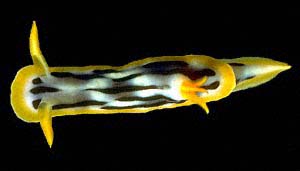
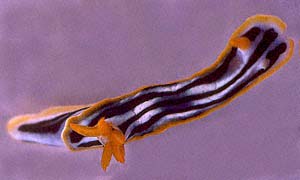
Chromodoris strigata
Rudman, 1982
Order: NUDIBRANCHIA
Suborder: DORIDINA
Family: Chromodorididae
DISTRIBUTION
reported from the Great Barrier Reef, Australia and Madagascar so probably has a wide tropical Indo-West Pacific distribution.
PHOTO
UPPER: Broadhurst Reef, Townsville, Queensland, October 1975. 15mm long preserved. PHOTO: I. Loch.
LOWER: Samaurez Reef, Coral Sea, October 1983. PHOTO: I. Loch.
This species has a characteristic pattern of dark translucent patches on the dorsum. They are arranged in a regular pattern, a pair behind the rhinophores, one in the centre of the dorsum and a pair just anterior to the gills.
This is another of the Chromodoris quadricolor colour-group of species. It has some similarities to Chromodoris elisabethina. See also Chromodoris cf. strigata and Chromodoris cf. strigata (2)
Reference:
• Rudman, W.B. (1982c) The Chromodorididae (Opisthobranchia: Mollusca) of the Indo-West Pacific: Chromodoris quadricolor, C. lineolata and Hypselodoris nigrolineata colour groups. Zoological Journal of the Linnean Society 76: 183-241.
Rudman, W.B., 1998 (November 19) Chromodoris strigata Rudman, 1982. [In] Sea Slug Forum. Australian Museum, Sydney. Available from http://www.seaslugforum.net/find/chrostri
Related messages
Re: Chromodoris strigata from Philippines
January 26, 2010
From: Franca Wermuth
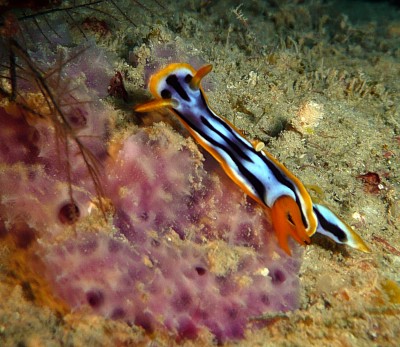
Concerning message #13086:
Dear Bill
Here's another Chromodoris strigata from the Philippines. There is something attached to the right side of the animal - sorry that the picture is not sharper.
Locality: Bonbon, Romblon Island, 20-30 m, Philippnes, Sibuyan Sea, 02 October 2009, steep slope. Photographer: Franca Wermuth.
Franca
franca.wermuth@gmx.ch
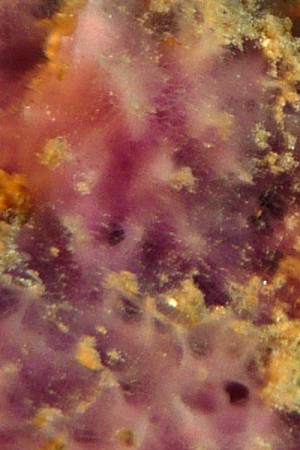
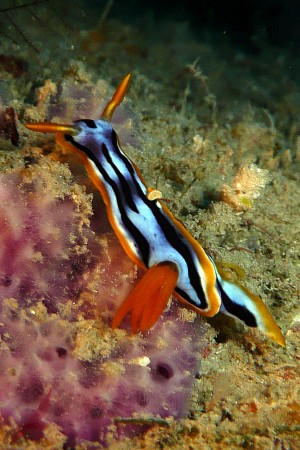
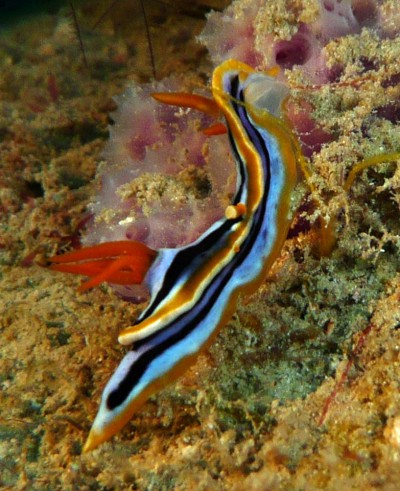
Dear Franca,
Although these are slightly out of focus, the sponge is definitely a species of the Dysideidae. Species of Chromodoris don't usually feed on sponges of this family but as we have other records of C. strigata feeding on dysideids [see messages #17409; #1086] we will need to look at this species more closely.
It is an interesting observation
Best wishes,
Bill Rudman
Chromodoris strigata from Solitary Ids, NSW
October 29, 2009
From: David & Leanne Atkinson
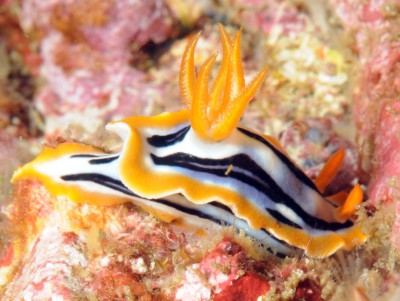
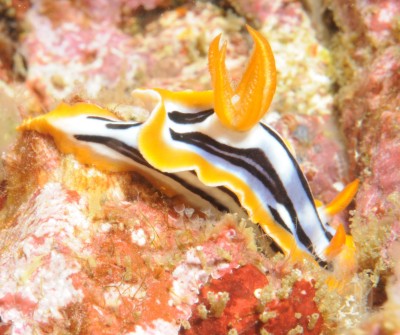
Concerning message #22728:
Dear Bill,
This is the animal we identified as Chromodoris magnifica. We didn't reposition it to get a clear shot and it was at the back of a ledge with its head down not a very good shot even though we both tried it a few different ways. The surge was too strong and it could have got swept away if we have dislodged it. Was our identification correct?
Locality: Elbow Cave, North Solitary Island, Solitary Islands Marine Park, 15 metres, New South Wales, Australia, Pacific Ocean, 23 December 2008, Coral Reef. Length: 30 mm approximately. Photographer: David and Leanne Atkinson.
Regards,
Leanne & David Atkinson
atk@hunterlink.net.au
Atkinson, D. & L., 2009 (Oct 29) Chromodoris strigata from Solitary Ids, NSW. [Message in] Sea Slug Forum. Australian Museum, Sydney. Available from http://www.seaslugforum.net/find/22732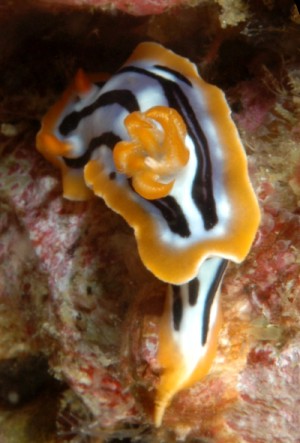
Dear David and Leanne,
I'm glad I asked you to send photos of this animal. It is not C. magnifica but a much rarer or seldom seen species, Chromodoris strigata. It hasn't been reported from New South Wales before, but is known from Queensland.
It is a bit difficult to separate these black-lined species with an orange border, but the translucent dark patches on the mantle and the white 'core' to each gill are quite characteristic
Best wishes,
Bill Rudman
Chromodoris strigata feeding on yellow sponge
March 10, 2009
From: Marcel Tanke
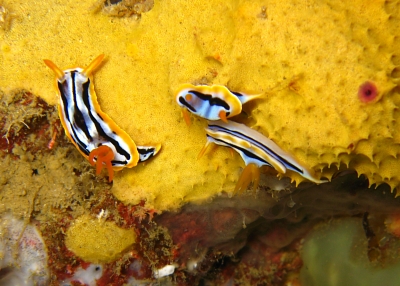
Concerning message #17461:
Hi Bill,
We found 3 Chromodoris strigata feeding on yellow sponge; a different type from what I could find in the C. strigata section.
Locality: Anilao, about 15 m, Philippines, 11 June 2008. Length: 3 cm max. Photographer: Marcel Tanke.
Best regards,
Marcel
marceltanke@cs.com
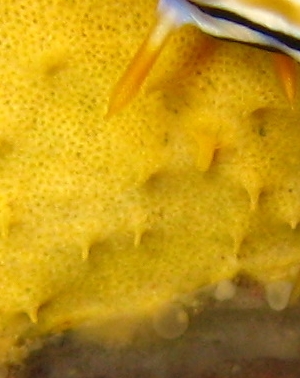
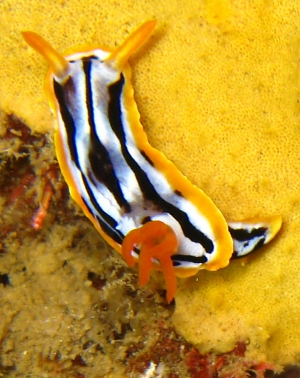
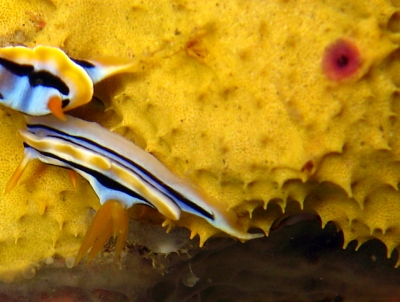
Dear Marcel,
Thanks for this record. Although I can't see any sign of actual feeding, the fact that three animals are all congregating on the same sponge colony would suggest they have more than a passing interest in it. C. strigata is a bit of a puzzle as far as its food in concerned. Out only earlier records suggest it feeds on dysideid sponges which are not usually eaten by species of Chromodoris. I am pretty sure the sponge in your photo is a species of Chelonaplysilla, which belongs to the sponge Family Darwinellidae, which is a chosen food of species of Chromodoris. Scott Johnson sent in a number of messages [see 12232] showing C. fidelis feeding on a number of species? colour forms? of Chelonaplysilla. Although not as brightly coloured as your sponge, the shape and structure of the colony is very similar. It will certainly be worth looking out for this species on similar sponges in the future.
Best wishes,
Bill Rudman
Chromodoris strigata ? from Tofo, Mozambique
August 23, 2007
From: Natasja Vandeperre
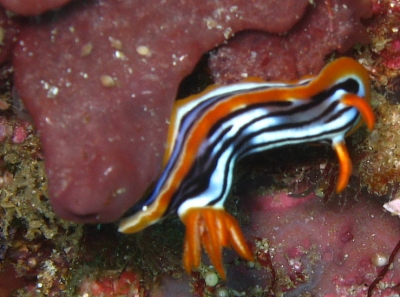
Dear Bill,
This Chromodoris looks a lot like Chromodoris magnifica but is it?
Locality: Tofo, Mozambique, Indian Ocean, 20 July 2007. Photographer: Natasja Vandeperre.
Greetings,
Natasja
postmaster@naaktslakken.be
Vandeperre, N., 2007 (Aug 23) Chromodoris strigata ? from Tofo, Mozambique. [Message in] Sea Slug Forum. Australian Museum, Sydney. Available from http://www.seaslugforum.net/find/20507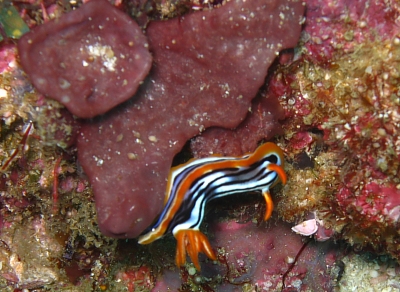
Dear Natasja,
This is one of a group of black lined species of chromodorid which still need a little more sorting out. I suspect this isChromodoris strigata but I am not 100% sure. The sponge it is on looks like the thorectid C. hamiltoni was on in your earlier message [#20505], but I don't know if that indicates a food choice, or just somewhere to sit. Other records suggest C. strigata feeds on a dysideid sponge.
Best wishes,
Bill Rudman
A Lion fish and Chromodoris strigata
June 15, 2007
From: Lior Harari
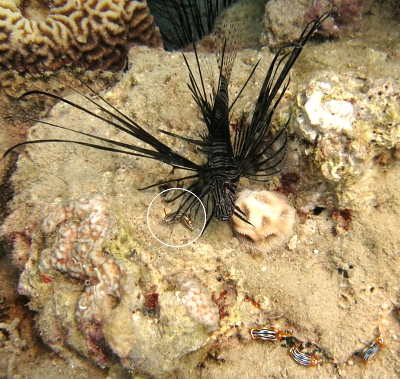
Hi,
This picture was taken about a year ago.
I noticed first that there is a slug skewered on the thorn-like fin rays of the Lion fish, then I noticed the murderer has some more victims. The other slugs look quite lively on the picture but I remember they looked quite dead and motionless (even for slugs).
I wouldn't have thought to blame the Lion Fish but it seems I caught him "red handed". I haven't given it any importance at the time but after looking at the page dedicated to the subject "what eat slugs " I figured this might be interesting.
Locality: Dekel beach, about 20 meters, Israel, Red Sea, 17 june 2006. Photographer: Lior Harari.
Take care,
Lior.
hararilior@yahoo.com
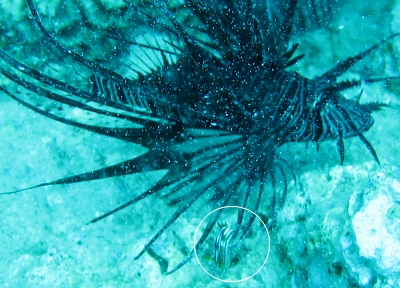
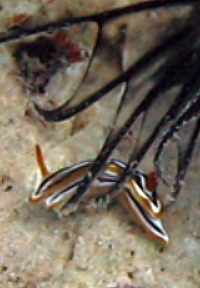
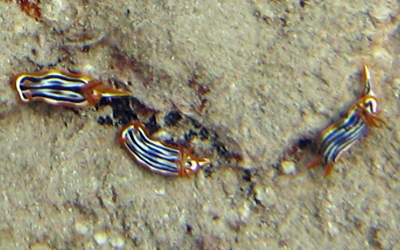
Dear Lior,
I think the Lions Fish's reputation amongst the friends of nudibranchs can stay intact. Looking carefully at your photos I think that the one on the fin spines looks quite healthy. I don't think it is 'skewered'. I am not sure what it is doing there. Perhaps the fish was being very still for a while and the slug just crawled on to the fin. My own experiences with these fish is that they grab food items very quickly - almost sucking them into their mouth. I may be wrong but I don't think a chromodorid would be sitting there with its gills and rhinophores fully extended if it was impaled on fin spines. Similarly the 3 slugs nearby also have their gills and rhinophores fully extended, indicating to me that they are 'happy'. I am pretty sure the slug is Chromodoris strigata
Best wishes,
Bill Rudman
Re: Chromodoris strigata from Sth Africa
August 23, 2006
From: Bruce Wilkie
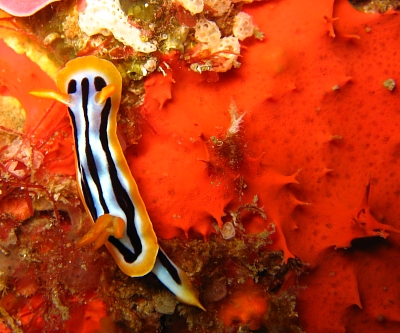
Concerning message #17409:
Hi Bill,
After seeing Colin`s message, I remembered that I had a photo of what I think is also C.strigata on a similar sponge which shows signs of damage.
I also came across another one of these animals a couple of days ago which is also on a sponge.
Locality: Upper right photo: Flat rock, North Stradbroke Island, Queensland, 13th August 2006, Depth 15 m. Lower photos:Flat Rock North Stradbroke Island, 16 metres, Queensland Australia, Pacific ocean, 21 May 2006, rocky reef with sponges, hard & soft corals . Length: 30 mm. Photographer: Bruce Wilkie.
Many Thanks,
Bruce Wilkie.
brucedwilkie@yahoo.com.au
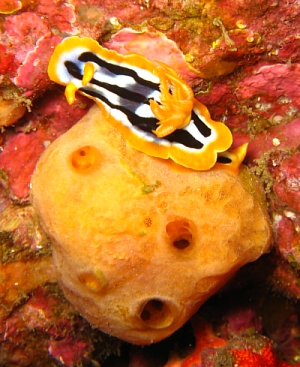
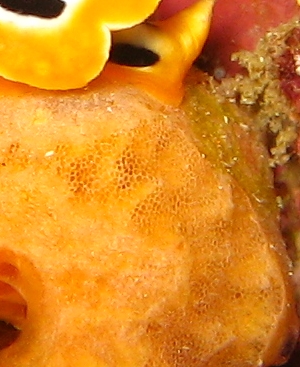
Dear Bruce,
This is certainly C. strigata. It certainly looks like sponge damage. I'll have to check it out.
Best wishes,
Bill Rudman
Chromodoris strigata from Sth Africa
August 14, 2006
From: Colin Ogden
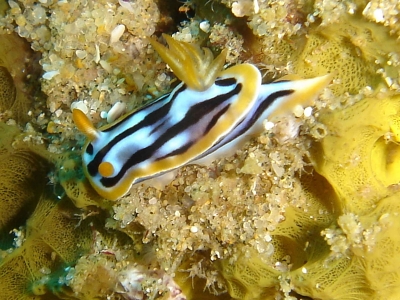
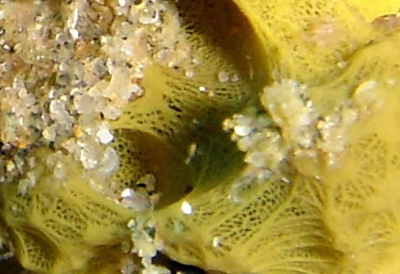
Hi Bill,
On a dive yesterday, I came across this little fellow. I have seen it before and assumed that it was a juv Chromodoris hamiltoni with a different colour variation, but yesterday I found 2 of them about 40 metres apart, and thought it might be worth sending to you for your comments.
thanks a ton
Locality: Sodwana Bay, 19 metres, South Africa, Indian, 8 August 2006, reef. Length: 20mm. Photographer: Colin Ogden.
Colin
scubaco@iafrica.com
Ogden C. M., 2006 (Aug 14) Chromodoris strigata from Sth Africa. [Message in] Sea Slug Forum. Australian Museum, Sydney. Available from http://www.seaslugforum.net/find/17409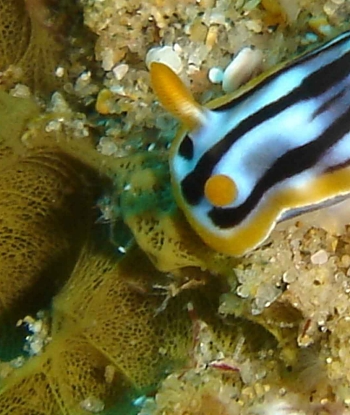
Dear Colin,
This is Chromodoris strigata, one of the confusing group of black-lined chomodorids. It is nice to get this photo because it shows its probable food sponge very clearly. I have two earlier records of its possible food sponge, which suggests it feeds on a species of dysideid. This much clearer photo will allow me to confirm the identity of the sponge.
Best wishes,
Bill Rudman
Chromodoris strigata in the Red Sea feeding?
October 12, 2005
From: Binyamin Koretz
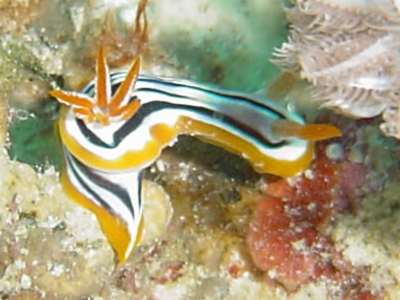
Dear Bill,
The attached photos show specimens of what we assume is the Red Sea version of Chromodoris strigata, based on your description of the 5 translucent spots on the dorsal, and they also match your ID of Marina's animal (msg #6728). The first photo is very typical of the coloration; the other 2 unfortunately were taken with our old camera.
This species is fairly common in Eilat in the spring months, March-June (which is a typical pattern for many species here, perhaps triggered by the warming phase of the annual water temperature cycle). The rest of the year we don't see it. (Putting that in writing guarantees that it will show up next week!) It appears to be active mostly in the daylight hours, and resting at night, if seen then at all. It tends to be more commonly found in the depths 25-35m, but there aren't any temperature differences which would explain that.
Locality: Eilat, various sites, Israel. Red Sea (Gulf of Eilat). Depth: 26 m-36 m. Length: typically about 2-3 cm. April 2004, May 2005. corals Photographer: Binyamin and Shulamit Koretz
In several photos, e.g., the 3 that I've attached, the slug can be seen 'nuzzling' small circles of a reddish-brown substance which I guess could be a sponge, and I guess it could be eating it or thinking about it.
I hope that this is helpful.
Best regards
Binyamin
www.koretz.net/Eilat/Invertebrates/Molluscs/Opistobranchs.htm
binyamin@koretz.net
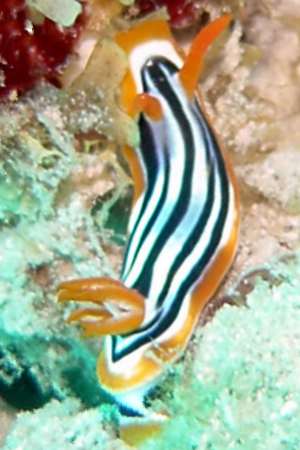
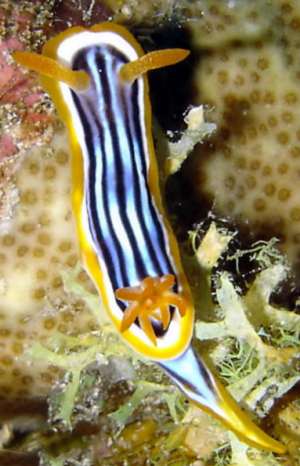
Dear Binyamin,
Thanks for these photos which I agree is what I am identifying as C. strigata. It seems in larger animals the lamellate part of the gills is clearly white. I would very much like to agree they are all feeding, but unfortunately, even on the larger scans you sent, I can't really be sure if the reddish patch is sponge or not. Thanks for hoping. I am sure you will in time find some chromodorids feeding, but some clearly are not going to make it easy for us.
Best wishes,
Bill Rudman
Chromodoris strigata from northern Sulawesi
June 27, 2005
From: Bob Whorton
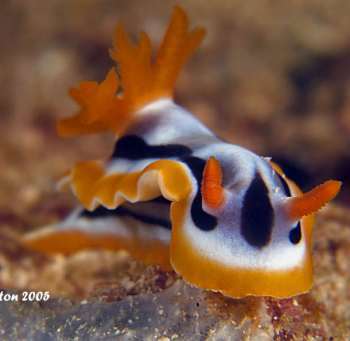
Hi Bill,
Not too sure on the ID of this Nudi I came across in Northern Sulawesi in May. Looks like Chromodoris magnifica, but I'm not so sure as this has horizontal grey bands across its back...
Locality: Bangka Island, Nothern Sulawesi, Indonesia. Depth: 8 m. Length: 3 cm. Middle of May. Sandy bottom (off coral reef). Photographer: Dr Bob Whorton
Bob Whorton
drbob.whorton@btinternet.com
Whorton, R., 2005 (Jun 27) Chromodoris strigata from northern Sulawesi. [Message in] Sea Slug Forum. Australian Museum, Sydney. Available from http://www.seaslugforum.net/find/14122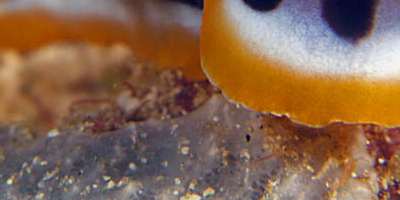
Dear Bob,
This is another of the black-lined species, in this case Chromodoris strigata. I am particularly interested in the grey sponge in the front of the photo which this slug seems interested in. Could you have a look at other photos you have of this animal and see if one shows the sponge in more detail. Although it doesn't actually look to be feeding, it looks as though it is an association worth following up on.
Best wishes,
Bill Rudman
Chromodoris strigata from Philippines
February 8, 2005
From: Sylvain Le Bris
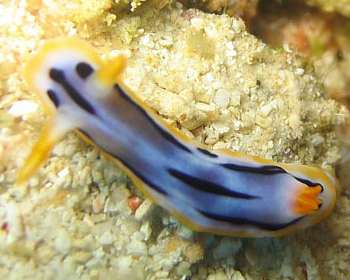
Hi,
Can you help me for the identification of this nudibranch found in the Philippines in March 2004. I think it is a juvenile.
Locality: Panglao Island, Philippines. Depth: 12 m. Length: 2 cm. March 2004
Thank you very much
Sylvain Le Bris
sylvain.lebris@freesbee.fr
Le Bris, S., 2005 (Feb 8) Chromodoris strigata from Philippines. [Message in] Sea Slug Forum. Australian Museum, Sydney. Available from http://www.seaslugforum.net/find/13086Dear Sylvain,
This is Chromodoris strigata.
Best wishes,
Bill Rudman
Chromodoris strigata from Malaysia
February 24, 2004
From: Paul Osmond
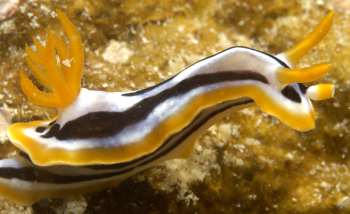
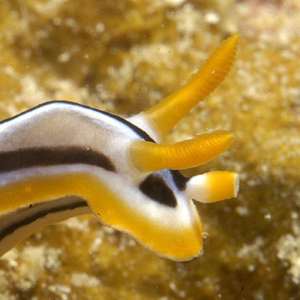
Dear Bill,
This image is from a friend of mine (Kasey Canton) and was taken in Malaysia in December 2003. I think it is Chromodoris joshi, but it is difficult to tell with so many closely patterned species.
Also what is on the front of this nudibranch? I can't say I have seen that growth out front before on any other species I have seen recently. (Kasey has given permission for this image to be used by the Sea Slug Forum)
Thanks
Paul
marriard@deepseaimages.com
Osmond, P., 2004 (Feb 24) Chromodoris strigata from Malaysia. [Message in] Sea Slug Forum. Australian Museum, Sydney. Available from http://www.seaslugforum.net/find/12273Dear Paul (and Kasey),
This is Chromodoris strigata. These black lined animals are sometimes difficult to separate but the background colour is white rather than blue, and there are a charcteristic pattern of translucent, non-pigmented patches on the mantle. Chromodoris joshi differs from the other similarly coloured species in having a pattern of opaque white spots, or specks, all over the mantle.
The strange growth at the front of the mantle is some developmental abnormality
Best wishes
Bill Rudman
Chromodoris strigata from Sulawesi
December 21, 2002
From: Mary Jane Adams
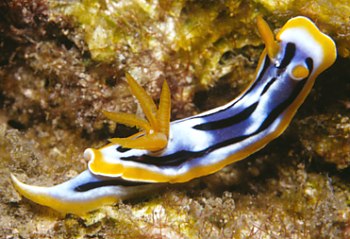
Hi Bill,
Here is another Chromodoris strigata for your database. What a beautiful animal! I found it on a volcanic sand slope with patch reef in Lembeh Strait, Sulawesi Island, Indonesia on Nov.21, 2002. The crawling length, including the tail was 28mm. Divesite: Makawidey, Depth: about 15 meters.
Mary Jane Adams
divepng@yahoo.com
Adams, MJ., 2002 (Dec 21) Chromodoris strigata from Sulawesi. [Message in] Sea Slug Forum. Australian Museum, Sydney. Available from http://www.seaslugforum.net/find/8657Thanks Mary Jane,
Bill Rudman
Chromodoris strigata from North Sulawesi
October 3, 2002
From: Marli Wakeling

Hello again,
Here is what I think is Chromodoris strigata from Nudi Falls ... an apt name for this great dive site.
Location: Nudi Falls, Lembeh Straight, North Suluwesi, Indonesia
Depth: 35 feet
Length 2.5 cm
Photograph: Marli Wakeling
Regards,
Marli
scubamarli@excite.com
Wakeling, M., 2002 (Oct 3) Chromodoris strigata from North Sulawesi. [Message in] Sea Slug Forum. Australian Museum, Sydney. Available from http://www.seaslugforum.net/find/8090Thanks Marli,
Bill Rudman
Chromodoris strigata? from the Red Sea
April 26, 2002
From: Marina Poddubetskaia
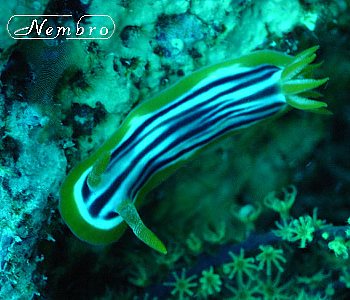
Dear Bill,
Here is another photo of a nudibranch I saw at the end of March, when I spent a week in Egypt. It was a dive cruise at the North of Red Sea, between Hurghada and Sinai mountains.
Is this Chromodoris quadricolor?
Best wishes,
Marina.
marina.poddubetskaia@francetelecom.com
Poddubetskaia, Marina. , 2002 (Apr 26) Chromodoris strigata? from the Red Sea. [Message in] Sea Slug Forum. Australian Museum, Sydney. Available from http://www.seaslugforum.net/find/6728Dear Marina,
There is a complex of black lined species and I still think we have a way to go to before they are completely separated. I think this is Chromdoris strigata. In all animals I have seen there is a consistent pattern of 5 large translucent grayish patches on the dorsum, 2 behind the rhinophores, 2 in front of the gills, and one in the centre. I can't recall it being recorded from the Red Sea as yet, but it is known from Madagascar at the southern end of the western Indian Ocean.
Best wishes.
Bill Rudman
Chromodoris strigata from the Solomon Ids
May 22, 2001
From: Scott Johnson
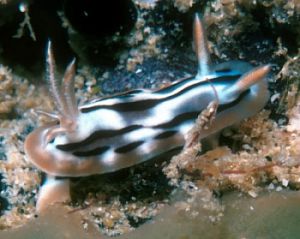
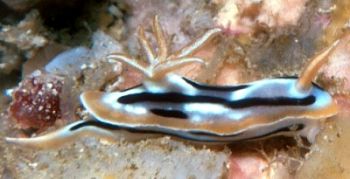
Hi Bill,
Here are a couple of Chromodoris strigata from the Solomon Islands. Both of these were found in the Florida group.
Scott
johnson@kmr.ll.mit.edu
Johnson, S., 2001 (May 22) Chromodoris strigata from the Solomon Ids. [Message in] Sea Slug Forum. Australian Museum, Sydney. Available from http://www.seaslugforum.net/find/4380Thanks Scott,
Bill Rudman
Another Chromodoris strigata from S. Africa
September 26, 2000
From: Valda Fraser
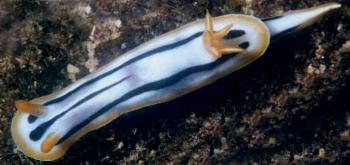
Dear Bill
Is this Chromodoris strigata? The patterning is wrong, but the colouring seems right. Thanks.
Locality: Park Rynie, south coast KwaZulu-Natal, SOUTH AFRICA, 32m
Date: September 2000
Size: 35mm
Valda Fraser
valdafraser@mweb.co.za
Fraser, V., 2000 (Sep 26) Another Chromodoris strigata from S. Africa. [Message in] Sea Slug Forum. Australian Museum, Sydney. Available from http://www.seaslugforum.net/find/3042Dear Valda,
I would certainly consider this to be C. strigata. The pattern certainly falls within the variation of that species.
Thanks for one I can identify,
Best wishes,
Bill Rudman.
Chromodoris strigata from Thailand
April 5, 2000
From: Narongpon Sittithaweepat
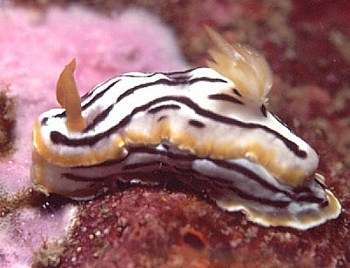
Dear Bill
I can't identfy this nudibranch. I found it at Surin Island in Thailand and photo by Dr. Thon Thamrongnawasawat. I record depth at 90 feet. I don't record date.
Thank you
Narongpon Sittithaweepat
chromodorid@thaimail.com
Sittithaweepat, N., 2000 (Apr 5) Chromodoris strigata from Thailand. [Message in] Sea Slug Forum. Australian Museum, Sydney. Available from http://www.seaslugforum.net/find/2204Dear Narongpon,
I like your email address. Chromodorids are my favourites to. I am pretty sure your animal is Chromodoris strigata. It seems that animals from the Indian Ocean have a quite opaque white background colour.
Best wishes,
Bill Rudman.
Chromodoris strigata from South Africa
January 27, 2000
From: Valda Fraser
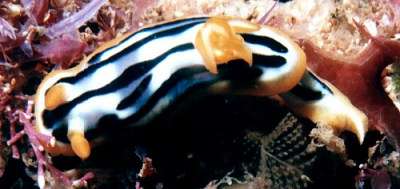
This is a part of Valda Fraser's message about Chromodoris africana and similarly coloured species from South Africa. I have copied it here for cross-reference ... Bill Rudman
Dear Bill
These black and white nudibranchs are confusing me. ... What is [this one] ?
South Coast, KwaZulu-Natal, South Africa.
Umkomaas, Jan 2000, 45mm
Regards
Valda Fraser
iti04937@mweb.co.za
Fraser, V., 2000 (Jan 27) Chromodoris strigata from South Africa. [Message in] Sea Slug Forum. Australian Museum, Sydney. Available from http://www.seaslugforum.net/find/1794Dear Valda,
This is C. strigata. To my knowledge I think this is the first record from South Africa, although I have seen a photo of one from Madagascar. Like all your intertsing finds, any information on its biology would be of great value.
Best wishes,
Bill Rudman.
Chromodoris strigata feeding
July 22, 1999
From: Neil Miller
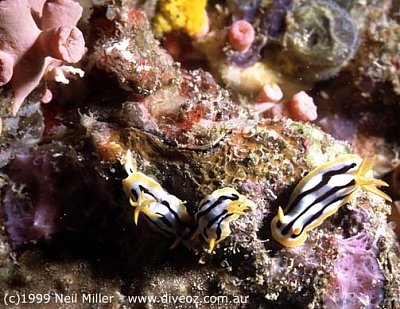
Hi Bill,
Here is the other photo that you were interested in from my website for Scuba Divers at http://www.diveoz.com.au. Again I'm sorry I can't give you any collection details.
Neil Miller
webguy@diveoz.com.au
Miller, N., 1999 (Jul 22) Chromodoris strigata feeding. [Message in] Sea Slug Forum. Australian Museum, Sydney. Available from http://www.seaslugforum.net/find/1086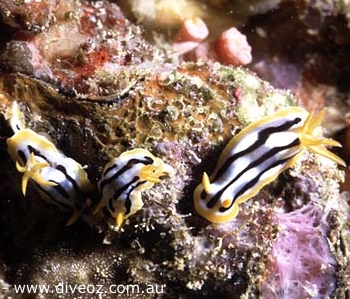
Dear Neil,
This photo of three Chromodoris strigata is particularly interesting because it is the first indication of what this species feeds on. I am pretty sure that these three animals have just about completely eaten a sponge colony. See the light purple or lilac coloured sponge in the bottom right of your photo. That is all that is left of a colony which seems to have extended over the bottom half of the rock they are sitting on.
It looks to be a species of Dysidea [Dysideidae; Dictyoceratida], a sponge genus commonly fed on by chromodorids, who tend to choose sponges without hard siliceous or calcareous spicules. Knowing the food of individual species can be a useful clue to whether two similarly looking 'species' are in fact the same or different.
Bill Rudman.
Rudman, W.B., 1999 (Jul 22). Comment on Chromodoris strigata feeding by Neil Miller. [Message in] Sea Slug Forum. Australian Museum, Sydney. Available from http://www.seaslugforum.net/find/1086Chromodoris strigata from SE Sulawesi
November 29, 1998
From: Lindsay Warren
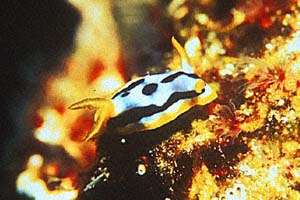
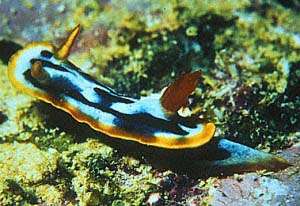
Dear Bill
Today I have attached pictures of several more Chromodorids from Operation Wallacea on Pulau Hoga in the Tukang Besi Islands off SE Sulawesi, Indonesia.
(upper photo 1.3 cm long).
Are these also Chromodoris strigata?
Thanks,
Lindsay Warren
100014.2112@compuserve.com
Warren, L., 1998 (Nov 29) Chromodoris strigata from SE Sulawesi. [Message in] Sea Slug Forum. Australian Museum, Sydney. Available from http://www.seaslugforum.net/find/341Dear Warren,
Yes these both are C. strigata. .. Bill Rudman.
Chromodoris strigata from Sulawesi
November 19, 1998
From: Lindsay Warren
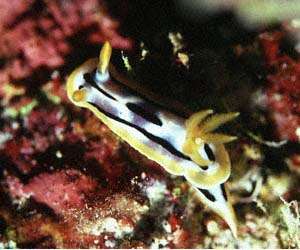
Dear Bill
Have just returned from three months once again working with Operation Wallacea on Pulau Hoga in the Tukang Besi Islands off SE Sulawesi, Indonesia.
Could you help us identify this photo? It'a another variant on the “Ch. annae / C. elisabethina" theme with a base of white, strong black markings and blotches of blue along the notum; orange mantle with thin white edge.
We have found many specimens with varying colour patterns which seem related to either Ch. annae or C. elisabethina and I will forward these to you as soon as they have been scanned in.
Many thanks for your help
Lindsay Warren
75 Netherwood Road,
London W14 0BP
100014.2112@compuserve.com
Warren, L., 1998 (Nov 19) Chromodoris strigata from Sulawesi. [Message in] Sea Slug Forum. Australian Museum, Sydney. Available from http://www.seaslugforum.net/find/318Dear Lindsay,
This is almost certainly Chromodoris strigata, which helps to fill in another gap in its known distribution.
Best wishes,
Bill Rudman.
